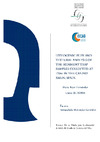Identificador persistente para citar o vincular este elemento:
https://accedacris.ulpgc.es/jspui/handle/10553/11943
| Título: | Lithogenic flux and textural analysis of the sediment trap samples collected at 150m in the Canary basin, Spain | Autores/as: | Báez Hernández, Maite | Director/a : | Menéndez González, Inmaculada | Clasificación UNESCO: | 2506 Geología | Fecha de publicación: | 2014 | Proyectos: | Ciclos Lunares y Fertilización Con Hierro. | Resumen: | Saharan desert dust is the major source of lithogenic fluxes input on the Canary Basin. Throughout the atmospheric lifetime, the dust particles are subject to mixing and ageing. These actions bring about significantly changes in the molecular composition of the airborne particles befare their removal from the atmosphere on the ocean surface. The "post-depositional" processes began in the ocean surface. This model assumed that once lithogenic particles encounter the micro-layer of the sea surface (made by organic compounds), it produces an important change in the composition of the lithogenic material. Physicochemical changes occur during particle settling through the water column producing aggregates. The distribution of the lithogenic particles along the water column depends on their size, morphology, density and aggregation processes. Oceanic samples were collected and analyzed from mesopelagic !ayer (at 150m depth), utilizing a P.P.S3/3-24 S time-series sediment trap, with a captation area of 0.125m2, and sampling frequency of 12 hours. The sediment trap was deployed in a drifting system between LCF3 and LCF4 station, 18.5 km apart from Gran Canaria Island, by LUCIFER II project, from January to April of 2011. Oceanic samples in water suspension were filtered using Nucleopore©. These filters were treated with hydrogen peroxide (3%) previously heated at 50°C in order to eliminare organic matter mass and particles. However, jelly masses (agglutinating particles) persisted after treatment. These masses remind to the Transparent Exopolymer Particles (TEPs). The lithogenic particles were characterized using the grainsize distribution and shape descriptors (Circularity Index (IC), Aspect Radio (AS). The particle identification, size and these indexes have been undertaken through image treatment, with ImageJ Program. This treatment allowed to characterize the whole particles size range and to estímate the particles volume. Ali samples were analyzed and photographed with a Leika" MZ6 stereomicroscope equipped with a photographic camera and non-polarized natural light at an image resolution of 5.0 megapixels. It was selected a Sx zoom to take the photographs and to run the image treatment analysis. A grid of 4mm was employed to sean through the whole fi!ter. Similar light conditions were fixed far each picture to guarantee a standard process in each filter. Multiple light facuses were used in order to avoid the creation of shadows. To discriminare particles a fi!ter Corel Paintshop Program was used. Saharan dust events were monitorized fallowing the web portal of the Barcelona Super Computing Cen ter (http://www.bsc.es/ earth-sciences/ mineral-dust-fo recast-system/bsc-dream86-forecast/ northafrica-europe-and-middle-ea-1). Airborne concentrations in the dust events during sampling days were up to 1 O µg/m3 and a dust deposition up to 2 mg/m2day. Saharan dust befare, during and after the sampling period, permitted to determine the terrigenous input into the Canary Basin and their lithogenic fluxes in Saharan dust events and the lithogenic fluxes at 150 m depth in the mesopelagic !ayer. | Departamento: | Física | Facultad: | Facultad de Ciencias del Mar | Titulación: | Grado en Ciencias del Mar | URI: | https://accedacris.ulpgc.es/handle/10553/11943 | Derechos: | by-nc-nd |
| Colección: | Trabajo final de grado |
En el caso de que no encuentre el documento puede ser debido a que el centro o las/os autoras/es no autorizan su publicación. Si tiene verdadero interés en el contenido del mismo, puede dirigirse al director/a o directores/as del trabajo cuyos datos encontrará más arriba.
Vista completaVisitas
57
actualizado el 23-ene-2024
Descargas
13
actualizado el 23-ene-2024
Google ScholarTM
Verifica
Comparte
Exporta metadatos
Los elementos en ULPGC accedaCRIS están protegidos por derechos de autor con todos los derechos reservados, a menos que se indique lo contrario.
